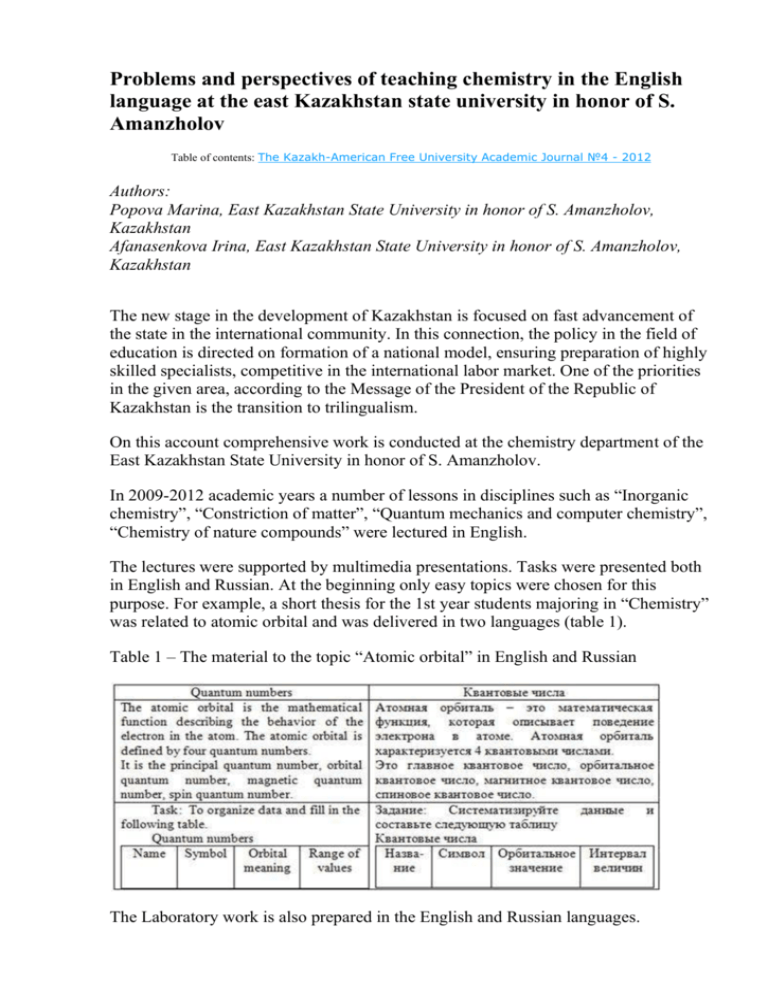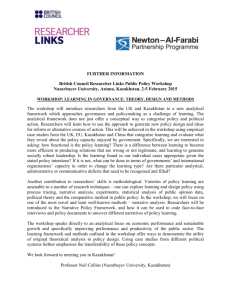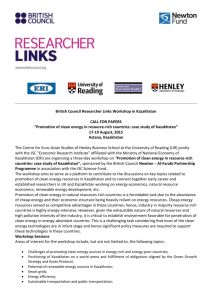Problems and perspectives of teaching chemistry in the English
advertisement

Problems and perspectives of teaching chemistry in the English language at the east Kazakhstan state university in honor of S. Amanzholov Table of contents: The Kazakh-American Free University Academic Journal №4 - 2012 Authors: Popova Marina, East Kazakhstan State University in honor of S. Amanzholov, Kazakhstan Afanasenkova Irina, East Kazakhstan State University in honor of S. Amanzholov, Kazakhstan The new stage in the development of Kazakhstan is focused on fast advancement of the state in the international community. In this connection, the policy in the field of education is directed on formation of a national model, ensuring preparation of highly skilled specialists, competitive in the international labor market. One of the priorities in the given area, according to the Message of the President of the Republic of Kazakhstan is the transition to trilingualism. On this account comprehensive work is conducted at the chemistry department of the East Kazakhstan State University in honor of S. Amanzholov. In 2009-2012 academic years a number of lessons in disciplines such as “Inorganic chemistry”, “Constriction of matter”, “Quantum mechanics and computer chemistry”, “Chemistry of nature compounds” were lectured in English. The lectures were supported by multimedia presentations. Tasks were presented both in English and Russian. At the beginning only easy topics were chosen for this purpose. For example, a short thesis for the 1st year students majoring in “Chemistry” was related to atomic orbital and was delivered in two languages (table 1). Table 1 – The material to the topic “Atomic orbital” in English and Russian The Laboratory work is also prepared in the English and Russian languages. Table 2 - An extract from the laboratory work “Determination of structural formula of substances” Before the lesson we introduce a new vocabulary to the topic of a lecture. The new words are given to the students to learn by heart at home and checked verbally for 2-3 minutes in the beginning of the lesson. Table 3 –Scheme of vocabulary to the topic “Atomic theory” Huge attention has been given to a good layout and presentation of the material in the form of figures, schemes, tables (fig.1). Fig 1 – The diagram from the practical work to the lecture “Carbohydrates” An important aspect here is the structural layout of the material presented in information blocks including the most important data necessary for understanding. Fig 2 – Slides from the presentation of the lecture “Atomic theory” Software used in Chemistry is also introduced in English. For example, demonstration of the program called HyperChem. HyperChem is a molecular modeling program. HyperChem provides chemical calculations, drawing and database capabilities, 3D visualization and animation. See in fig 3. Fig 3 – Construction of ethylene’s electronic spectrum by the HyperChem program To assess the level of the students’ knowledge we used tests with open-ended and closed-ended questions. For example: Please answer the questions: 1. The particles in an atomic nucleus are collectively known as… 2. The total number of electrons in the 4th energy level is… 3. Atomic orbital is a… 4. How many quantum numbers are necessary to describe the atomic orbital? Having analyzed data, it is necessary to emphasize the necessity of application of the following principles while teaching chemical disciplines in English: 1. Studying a new vocabulary before lectures; 2. Systematizing and structuring of the material; 3. Complex use of various methods and teaching techniques; 4. Combination of bilingual training 5. Continuity and sequence At the same time, while teaching chemical disciplines in English we faced such problems as insufficient language competence of students majoring in Chemistry for comprehension of lectures. It is necessary to develop training techniques for students majoring in technical disciplines to be taught in English and introduce additional language disciplines. Development of a new major «Ecological chemistry» with an extensive learning of foreign languages is being considered for the students of the specialty «5B060600-Chemistry». The students are admitted to the specialization lectured in English if they answered correctly on 70% of questions in the test. The test contains different questions and assesses 4 types of the skills: reading, writing, speaking, listening. Fig 4 - Main skills in the English Test for Students Majoring in Chemistry Example of the test is shown below in figure 5. Fig 5- An extract from the test for students, majoring in Chemistry The elective disciplines such as «Translation theory», «Bilingual translation of technical documentation» are included into the curriculum for the 2 nd year students. This way it will be possible to develop language competence in students. We also included elective chemical disciplines lectured in English for the 3d year students. Difficulties here are caused by absence of methodical material in English. We think that nowadays the problem of training specialists in English requires detailed research, which should be consecutive and substantial. To do productive work in this direction it is necessary to actively apply both local and foreign higher education practices, and also invite foreign professors with the purpose of delivering certain lectures in English. REFERENCES 1. Law of the Republic of Kazakhstan "About education". (July 27, 2007 N 319-III). 2. State program of the development of education of the Republic of Kazakhstan for 2011-2020. (2011). Astana, p.63. 3. State program of the development and application of languages of the Republic of Kazakhstan. (Decree of the President of the Republic of Kazakhstan as of June 29, 2011 ¹ 110) Table of contents: The Kazakh-American Free University Academic Journal №4 - 2012




